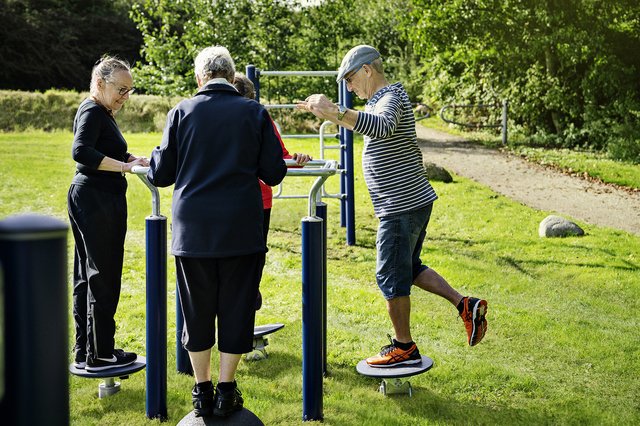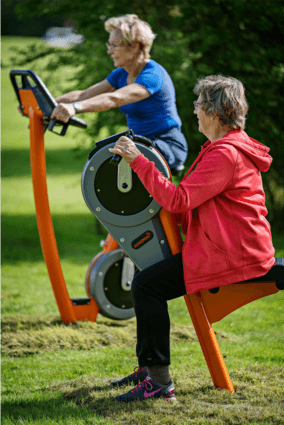Article originally printed on KOMPAN. Reprinted with permission. Photos courtesy of KOMPAN.
The Shift To An Aging Population
The future will see an increased proportion of elderly people throughout all modern societies. It is estimated by the WHO (World Health Organization) that in the year 2050 there will be equally as many elderly people in the world as there are children (1). Not only will there be more elderly people but the perception of being old will also continue to change. Previously, age was seen as a natural weakness process and reduction in lifestyle options. While this still holds true in many respects, this perception has shifted towards a higher chronological age group. In the future, people aged 65-75 will expect to have the same quality of life and life options as younger persons. As an illustration of this change in perception, this age-group (65-75) has been referred to as “yold” (young old) (2) and the percentage of “yold” in affluent countries has already increased from 8% in 2000 to 11% in 2015. In relation to outdoor fitness, this means that we can expect more users in this segment, and that those users will have a higher activity level and a higher demand for tailored, effective solutions.
The Physiological Decline From Becoming Old
Increased age does mean physiological changes and decreased physical performance, but much of this is attributed to decreased levels of physical activity and can therefore be prevented or reduced by regular exercise (3). One of the most obvious symptoms of age and inactivity is the loss of muscle strength. After the age of 50, we tend to lose around 1% of muscle strength per year with further accelerated loss after the age of 75. However, most of this can be prevented through regular strength training, and research has shown that even at an older age, muscle mass can be increased (4).
Another age-related problem is reduced cardiometabolic health, which increases the risk of diseases such as cardiovascular disease and type 2 diabetes. This can (to a large extent) be prevented with aerobic exercise and increased amounts of general physical activity. As there is a direct relationship between cardiorespiratory fitness and expected lifespan, this means that the aerobically fit elderly will live longer and with less years suffering from disease (5).
 The Risk of Falling
The Risk of Falling
A very common problem for the elderly is the increased risk of falling due to decreased muscle function and declining motor skills. Approximately 1 in 3 people above the age of 65 are expected to experience a serious fall event. Research has also shown that elderly people who experience a traumatic event are more likely to survive if they have previously had strong muscles (6). Similar to other ailments, the increased risk of falling can be related to decreased physical activity levels, and many studies show that the risk for falling can be significantly reduced with exercises that target gait function, balance and muscle strength (7). In many studies, the risk reduction for falling after a given exercise period is around 30% (8).
Best Exercise for Preventing Lifestyle Diseases
The best exercise for preventing most lifestyle diseases is a combination of cardio training, strength training, and generally increased physical activity level. Cardio training can have a protective effect at many different intensities, but the higher the intensity, the less time is required (8). Strength training increases muscle strength and the metabolic capacity of the muscles. For strength training to be effective, exercises should be performed in a way that sees the target muscles reach fatigue within 15 repetitions (9). This can be done with either adjustable external resistance or equipment that facilitates using bodyweight in varied positions. Increased cardiovascular fitness and well-trained muscles not just only improves the metabolic profile, but also allows the person to do more and thereby maintain a high general physical activity level more easily.
Best Exercise for Fall Prevention
It is generally recognized that falls can be prevented by doing a mix of balance, mobility and task-oriented exercises (7, 10). Balance exercise can be performed as static exercises (i.e. one-legged stand), but studies have shown that reactive balance training has an even higher potential (11). Reactive balance training not only means that the person is unstable, but also that the surface can move. Mobility as a term covers the ability to move (like walking), but also the general ability to perform functional movements. Decreased mobility can be a result of poor flexibility in both the upper and lower body. It is therefore important to maintain full-body flexibility. Simple exercises enhance basic physical performance, but task-oriented exercises are needed to improve more complex functional capacity (12). Examples of task-oriented exercises include walking on challenging surfaces, ramps and stairs. The important feature of these task-oriented exercises is that they specifically enhance the interplay between sensory feedback, reflexes, and motor skills.

Social and Emotional Factors of Exercise for the Elderly
An important motivational factor for elderly people to exercise is the social construct around the activity (13). To create solutions that make the elderly exercise consistently, it is therefore important to think about the layout of facilities, surroundings, and supportive items (furniture etc.). Another very important feature is the feeling of safety. Activity areas for the elderly should be away from noisy youth activities (like skate parks), be well lit in the evening, and pathways and other infrastructure should be laid out so it minimizes risk of trips and falling and maximizes the feeling of safety. (See example of a complete active agers solution from KOMPAN)
Quality of Life
Self-perceived quality of life is to some extent a subjective assessment, but it is very important as it indicates exactly as the term says: how well a person perceives his or her life. Also, people with a high self-perceived quality of life tend to live longer (14). Some of the underlying modifiable factors are absence of disease and accidents, the ability to actively do things you like, having a social network, and being able to take care of your own life. All these things can be directly positively affected by engaging in physical activity programs with other people.
Economic Benefits for Society
It is estimated that in the US alone, each year about US$50 billion is spent on non-fatal fall injuries and US$754 million is spent on fatal falls. With a greater elderly population expected in the future, these numbers are expected to grow (15). Decreasing the number of falls among the elderly can directly save large amounts of money as well as human suffering.
It has also been calculated that a general increase in people’s activity level can save on health costs. Each category change of a person’s activity level is related to a change in the expected annual health costs of US$815. A category change would be classed as going from “inactive” to “insufficiently active” or from “insufficiently active” to “active”. These numbers are calculated on population level, but it underlines that giving everybody the opportunity to lead a healthy lifestyle can have a significant impact on public healthcare costs (16).
Summary
In the future, there will be a larger proportion of elderly people and they will have higher expectations of what they can do in their senior years. With aging follows a physiological decline and increased risk of lifestyle-related diseases, but this can to a large extent be postponed or reduced through exercise. Also, the age-specific increased risk of falling can significantly be reduced with an appropriate exercise plan. Less disease and accidents and higher functional capacity in daily life means increased quality of life for the individual and less health-related expenses for society. The optimal exercise regime to achieve these benefits is a mix of cardio, strength, and fall-preventing exercises, preferably performed in motivating facilities together with like-minded persons.
Free Webinar
Join Rob and MOreten of KOMPAN Fitness Institute for this free presentation to learn How To Create Great Outdoor Fitness Spaces for Maximum Community Interaction.
Article originally printed on KOMPAN. Reprinted with permission. Photos courtesy of KOMPAN.
KOMPAN is #1 supplier of innovative playground and fitness equipment in the world.
The KOMPAN Fitness Institute is a global network of sports and fitness experts and professionals who share knowledge and trends and conduct research. The network maintains strategic partnerships with all sorts of local parties, including universities, researchers, scientists and fitness experts that are of value in terms of improving knowledge about sport and fitness at large.
References
- Economic and social implications of aging societies. Harper S. Science 2014
- The decade of the “young old” begins. The Economist, Nov. 2019
- Copenhagen Consensus statement 2019: physical activity and ageing. Bangsbo J et al. Br J Sports Med 2019
- Sarcopenia and Its Implications for Metabolic Health. Hunter GR et al. Journal of Obesity 2019
- Association of Cardiorespiratory Fitness With Long-term Mortality Among Adults Undergoing Exercise Treadmill Testing. Mandsager et al. JAMA Network Open. 2018
- Muscle strength before and mortality after a bone fracture in older people. Rantanen T et al. Scand J Med Sci Sports. 2002
- A CDC Compendium of Effective Fall Interventions: What Works for Community-Dwelling Older Adults. Stevens JA & Burns E. National Center for Injury Prevention and Control Centers for Disease Control and Prevention. 2015
- Comparison of cardioprotective benefits of vigorous versus moderate intensity aerobic exercise. Swain DP & Franklin BA. Am J Cardiol. 2006
- A meta-analysis to determine the dose response for strength development. Rhea MR et al. Med Sci Sports Exerc. 2003
- Effectiveness of a Fall Prevention Exercise Program on Falls Risk in Community-Dwelling Older Adults. Thompson CJ et al. Translational Journal of the ACSM. 2019
- Neuromuscular and Kinematic Adaptation in Response to Reactive Balance Training – a Randomized Controlled Study Regarding Fall Prevention. Krause A et al. Front Physiol. 2018
- Interventions to Improve Walking in Older Adults. Brach and VanSwearingen. Curr Transl Geriatr and Exp Gerontol Rep. 2013
- The acceptability of physical activity interventions to older adults: A systematic review and meta-synthesis. Devereux-Fitzgerald A et al. Soc Sci Med. 2016
- Health-Related Quality of Life and Mortality in a General and Elderly Population of Patients With Type 2 Diabetes (ZODIAC-18). Landman GWD et al. Diabetes Care. 2010
- Medical Costs of Fatal and Nonfatal Falls in Older Adults. Florence CS et al. Journal of the American Geriatrics Society, 2018
- Physical activity and associated medical cost savings among at-risk older adults participating a community-based health & wellness program. Towne SD et al. PLoS ONE 2018


